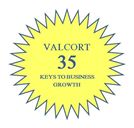Re-inventing the mission statement.
[Valcort 35 Keys to Business Growth: #8: Have a mission statement that is easy to understand with clear benefits for employees, customers and vendors.]
It’s time to re-invent the mission statement.
A mission statement clarifies purpose. It describes what an organization does, defines the core activity and sets the boundaries for the output of the work. It brings clarity to how you organize and do your work.
But in our work with over a hundred organizations of all types and sizes, too often a mission statement is relegated to words, dust and irrelevance. There is little value to it.
People’s expectations of the behavior and culture of organizations are changing. Burned by headlines of corporate greed and stories of government glut, people want more information. “Who can we trust?” they say. It’s not enough just to know the “what.” Industry-leading, innovative and transformative organizations are learning to tell the “why.”
Yes, it is time to re-invent the mission statement.
1. Build trust by explaining the “why”
VALCORT- driven companies understand that a mission statement is more than a lifeless document. It is an important tool that can bring focus, create trust, and inspire engagement among all those who have a stake in the organization’s future. If, as I’ve written, trust is the currency of commerce, then establishing shared stakeholder values by connecting mission to meaning is a wise move.
For many of your stakeholders, particularly the next generation, the “why” a company does things is as important as “what” the organization does.
2. It takes a village to accomplish a mission
To accomplish an organization’s mission requires people working together, doing work that results in a valuable product or service. In general, organizations need employees to make and offer the product or service. They need vendors to support employees’ with goods and services so they can do their work, and they need customers who are willing to pay for it. A mission cannot be accomplished by drafting a statement, even with leaders driving the mission. It must include the understanding and participation of a company’s many parts.
Without this fundamental understanding of an important and valuable mission, a company can get unknowingly stuck, with internal confusion and external ho-hum. Employees won’t invest as deeply in your organization’s growth. Vendors will think transactionally. Customers can view your offering as “one of many.”
Studies abound indicating that people want their work to have meaningful purpose. We all want to make a difference. If customers, employees and vendors understand the “why” of your organization’s mission, they’re more likely to engage in the “what” more fully and sacrificially.
If your employees, vendors and customers don’t know or value your mission, you’re cutting yourself short.
Mission Statement 2.0
To maximize growth, stakeholders need to understand the mission and the value or benefit the organization offers.
I propose a new format for today’s mission statements that includes not only the “what” (what we do, what we make and for whom we make it), but also the “why (who benefits from our dedication to this purpose and how they experience that benefit).
So what does the re-invented mission statement, Mission Statement 2.0, look like? Here’s what the mission of a fictional company, “SmartHaus Ceramics,” might be: “SmartHaus Ceramics’ mission is to design, develop and manufacture the most innovative, non-conductive, non-metallic ceramic fasteners for smart-house construction through a community of employees and vendors dedicated to keeping families safe while improving Wi-Fi connectivity.“
Similarly, the 2.0 mission statement of a Fortune 500 company will improve stakeholder engagement and trust, regardless of b2b or b2c, and regardless of their industry. Does this statement include a hint of the value proposition? Absolutely. Mission Statement 2.0 is one more tool to build trust at every point of contact.
It’s time to re-invent the mission statement–to bring purpose, meaning and value together. Let’s get started.
The Valcort 35 Keys to Business Growth. Over many years and hundreds of client relationships and strategic marketing opportunities, we have established the Valcort 35 Keys to Business Growth, best practices that build trust, align values with products and practices, and create organic growth. We are exploring these 35 practices, one at a time, on these pages. Find them all, as they’re introduced, here.
Tags: mission statement, Valcort 35 Keys to Business Growth





